Giochi dell'Oca e di percorso
(by Luigi Ciompi & Adrian Seville)
(by Luigi Ciompi & Adrian Seville)

|
Giochi dell'Oca e di percorso
(by Luigi Ciompi & Adrian Seville) |

|
 |

Torna alla ricerca giochi (back to game search) |
 |
| Nouvelle Combinaison du Jeu du Juif - New Combination of the Game of the Jew | ||
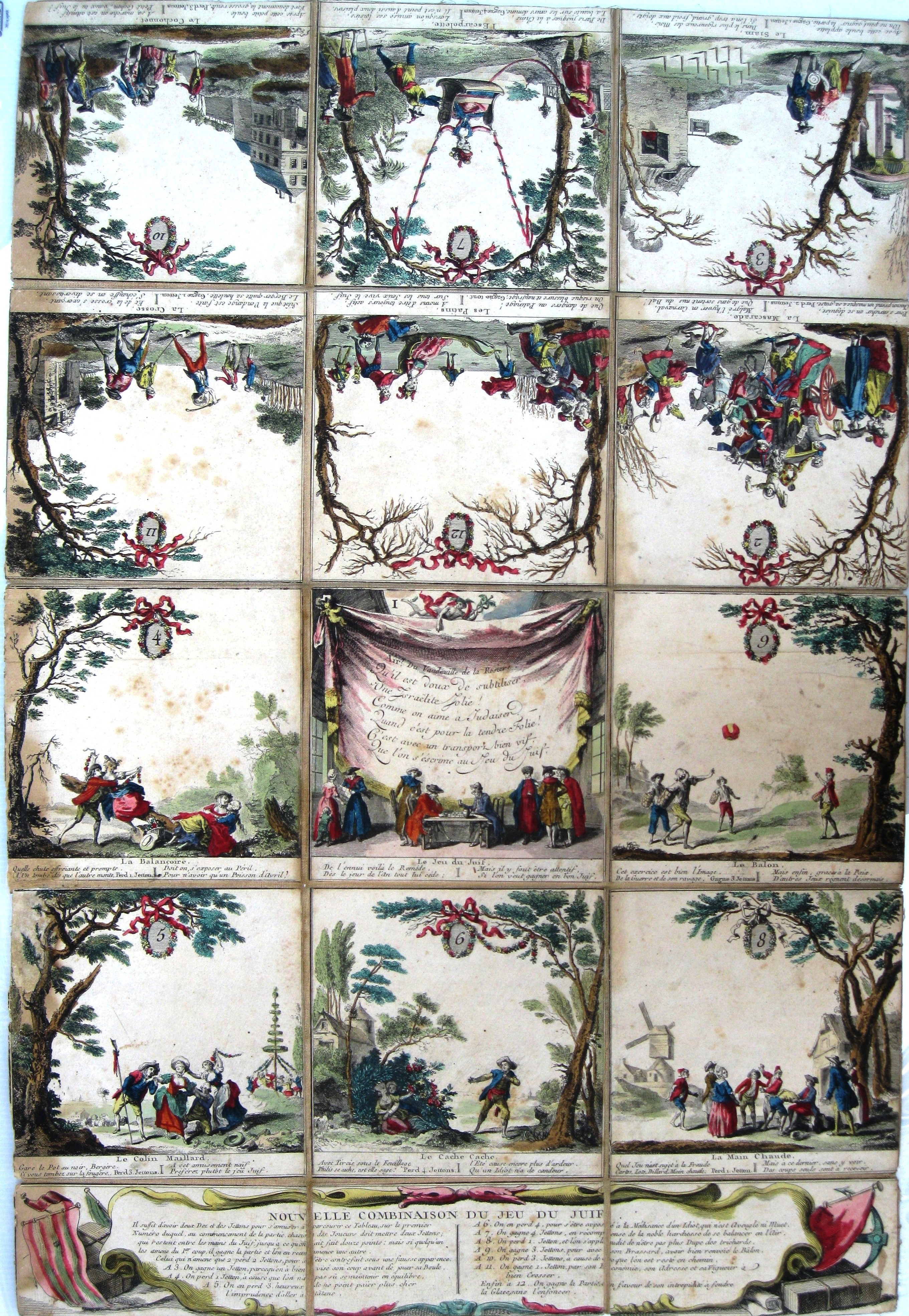 |
Versione stampabile
 |
Invia una segnalazione

|
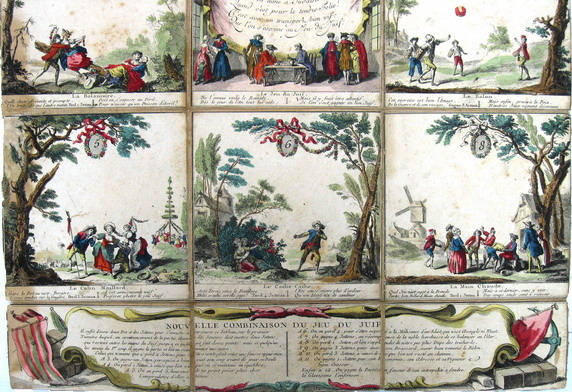 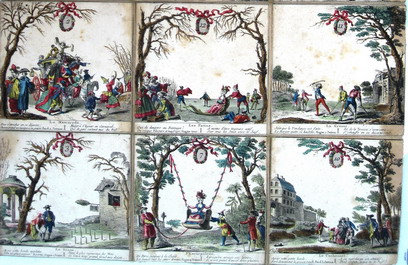 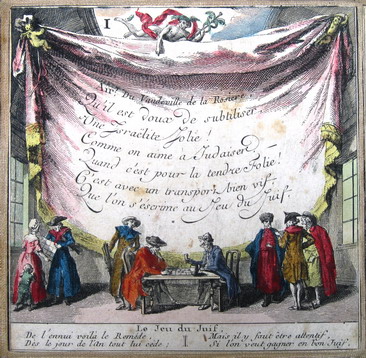 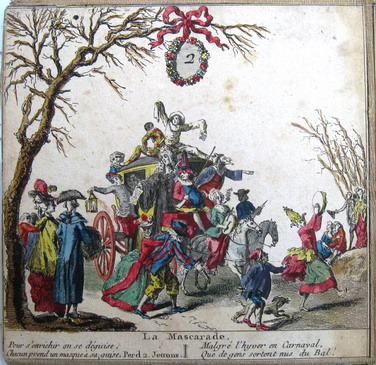 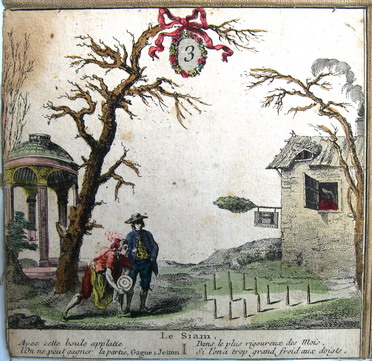 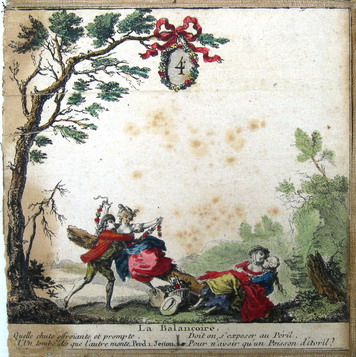 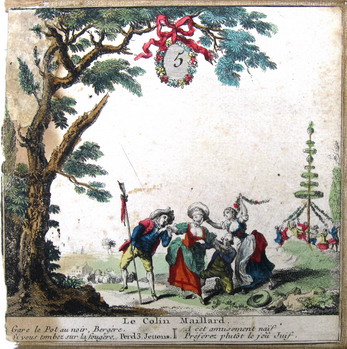 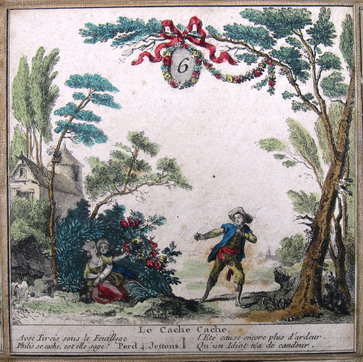 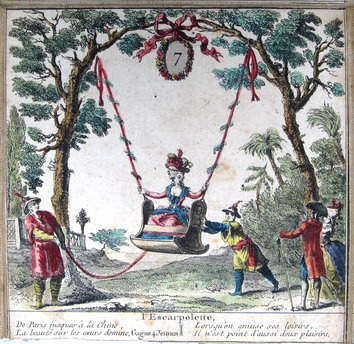 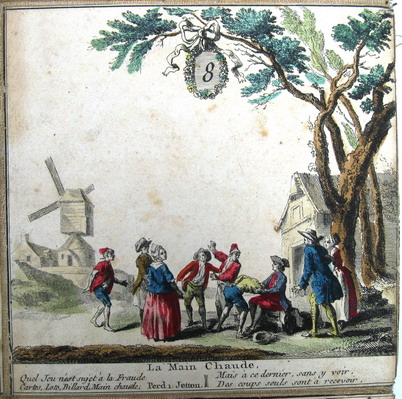 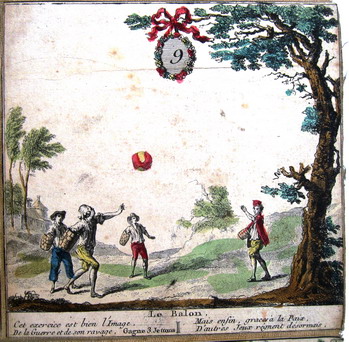 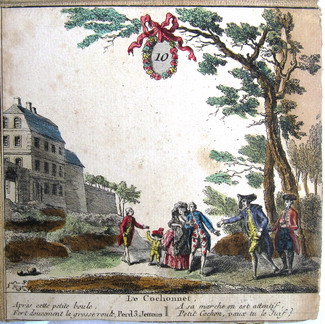 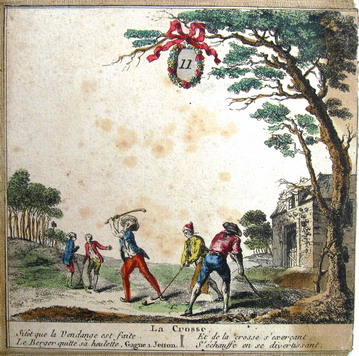 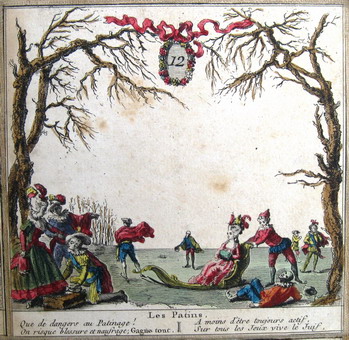 |
primo autore: | Desrais Claude-Louis (?) |
| secondo autore: | Crepy | |
| anno: | 1783 | |
| luogo: |
Francia-Parigi |
|
| periodo: | XVIII secolo (4°/4) | |
| percorso: | Gioco con i dadi | |
| materiale: | carta (paper) (papier) | |
| dimensioni: | 708X480 | |
| stampa: | Acquaforte colorata a mano (taille-douce colorée à la main) (hand-coloured etching) | |
| luogo acquisto: | ||
| data acquisto: | ||
| dimensioni confezione: | ||
| numero caselle: | 12 | |
| categoria: | Lotterie, fortuna, gioco d'azzardo | |
| tipo di gioco: | Gioco con i dadi | |
| editore: | Crepy (?) | |
| stampatore: | Crepy (?) | |
| proprietario: | Collezione A. Seville | |
| autore delle foto: | A. Seville | |
| numero di catalogo: | 2205 | |
| descrizione: |
Gioco con i dadi, composto da 12 caselle disposte in 4 file di 3 caselle ciascuna, che rappresentano dei giochi dell'infanzia all'aria aperta ispirati all'opera (Les Jeux) del pittore francese Nicolas Lancret (Parigi, 22 Gennaio 1690 - 14 Settembre 1743. Vedi D'Allemagne, pag. 205). Le prime 6 caselle sono rivolte verso l'alto e quindi sono al rovescio. Delle 12 caselle che ricordano i mesi dell'anno, 11 mostrano dei giochi praticati all'aperto e la casella centrale (n°1) presenta dei personaggi che giocano al tavolo con dei dadi e contiene dei versi di Du Vaudeville de la Rosière. Nel "Mercure de France", N° 23, Samedi 7 Juin 1783, si fa riferimento a questo gioco (che viene attribuito a Crepy) ed ai vari prezzi di vendita in base al formato: bianco e nero, colorato, in astuccio etc...("Le Jeu du Juif, assimilé à douze tableaux, représentant les jeux de l'adolescence usités pendant les douze mois de l'année. Ce Jeu, gravé en une grande feuille, se vend 2 livres, colorié 3 livres; dans un'étui 5 liv. en coffret, avec surprise, dez&jettons 8 livres. A Paris, chez Crepy, rue S. Jacques; & chez les Confiseurs&Tabletiers; & en Province, chez les Marchands d'Estampes"). Nel gioco non sono indicati né l'autore, né la data (è verosimile che il gioco sia stato realizzato da Crepy il quale ha omesso di inserire il proprio nome per paura di denuncia per plagio). Si ha notizia di 12 stampe numerate di giochi contenute in album con titolo "Le Jeu du Juif" e che insieme formano le caselle del gioco che porta lo stesso nome (Damascène Morgand, libraio e mercante di stampe di Ferdinando di Rothschild proponeva nel suo Bollettino mensile n°29 del Novembre 1891: ...très jolie suite de 12 estampes, numérotées formant les casiers du Jeu du Juif, jeu qui devait offrir beaucoup de similitude avec le jeu de l'oie. . . Ces gravures avec chacune plusieurs personnages sont charmantes et dans le genre de Desrais.) Il gioco può essere giocato in due modi: il primo come lotteria da salotto in cui in base al risultato ottenuto con i dadi o si prende o si lascia sul tavoliere; il secondo come un gioco di percorso anche se atipico. REGOLE: in basso. "Nouvelle Combinaison du Jeu du Juif. Il suffit d'avoir deux Dez et des Jettons pour s'amuser à parcourir ce Tableau, sur le premier Numero duquel au commencement de la partie chacun des Joueurs doit mettre deux Jettons qui restent entre les mains du Juif jusqu'à ce qu'on ait fait douze points; mais si quelqu'un les amene du 1er coup il gagne la partie et l'on en recommence une autre. Celui qui n'amene que 2, perd 2 Jettons pour s'etre contrefait sous une fausse apparence. A 3. On gagne un Jetton parcequ'on à bien visé son coup avant de jouer sa Boule. A 4. On perd 1 Jetton à cause que l'on a pas su se maintenir en équilibre. A 5. On en perd 3 heureux de ne point paier plus cher l'imprudence d'aller à tatons. A 6. On en perd 4 pour s'etre exposé à la Médisance d'un Idiot qui n'est Aveugle ni Muet. A 7. On gagne 4 Jettons en récompense de la noble hardiesse de se balancer en l'Air. A 8. On perd 1 Jetton et l'on s'applaudit de n'etre pas plus Dupe des trichards. A 9. On gagne 3 Jettons pour avec son Brassard avoir bien renvoie le Balon. A 10. On perd 3 Jettons à cause de ce que l'on est resté en chemin. A 11. On gagne 1 Jeton par son Economie, son Adresse et sa Vigueur à bien Crosser. Enfin à 12. On gagne la Partie en faveur de son intrepidité à fendre la Glace, sans l'enfoncer" CASELLE: con didascalia e versi. Cas. 1): "Air? Du Vaudeville de la Rosière/ Qu'il est doux de subtiliser/ Une Israelite Jolie/ Comme on aime Judaiser/ Quand c'est pour la tendre folie!/ C'est avec un transport bien vif/ Que l'on s'escrime au Jeu du Juif"/ "De l'ennui voilà le remède. / Dès le jour de l'An tout lui céde; / Mais il faut etre attentif, /Si l'on veut gagner en bon Juif." Cas. 2): La Mascarade; / "Pour s'enrichir on se déguise/ Chacun prend un masque à sa guise/ Malgré l'hyver en Carnaval/ Que de gens sortant nus du Bal!"/ Perd 2 Jettons Cas. 3): Le Siam;/ Avec cette boule applatie/ l'On ne peut gagner la partie/ Dans le plus rigoreux des Mois/ Si l'on a trop grand froid aux doigts"/ Gagne 1 Jetton Cas. 4): Le Balançoire;/ Quelle chute effroiante et prompte/ L'Un tombe dés que l'autre monte/ Doit on s'exposer au Péril/ Pour n'avoir qu'un Poisson d'Avril"/ Perd 1 Jetton Cas. 5): Le Colin Maillard; /"Gare le Pot au noir, Bergère/ Si vous tombez sur la fougère/ A cet amusement naif/ Préférez plutot le jeu Juif"/ Perd 3 Jettons Cas. 6): Le Cache Cache;/ "Avec Tircis sous le Feuillage/ Philis se cache, est elle sage?/ l'Eté cause encore plus d'ardeur/ Qu'un Idiot n'a de candeur"/ Perd 4 Jettons Cas. 7): L’Escarpolette/ "De Paris jusques à la Chine/ La beauté sur le coeurs domine/ Lorsqu'on amuse ses loisirs/ Il n'est point d'aussi doux plaisirs"/ Gagne 4 Jettons Cas. 8): La Main Chaude;/ "Quel Jeu n'est sujet à la Fraude/ Cartes, Loto, Billard, Main chaude;/ Mais à ce dernier sans y voir/ Des coups seuls sont à recevoir"/ Perd 1 Jetton Cas. 9): Le Balon;/ "Cet exercice est bien l'Image/ De la Guerre et de son ravage/ Mais enfin grace à la Paix/ D'autres Jeux régnent désormais/ Gagne 3 Jettons Cas. 10): Le Cochonnet;/ "Apres cette petite boule/ Fort doucement la grosse roule/ A sa marche on est attentif/ Petit Cochon vaux tu le Juif?/ Perd 3 Jettons Cas. 11): La Crosse;/ "Sitot que la Vendange est faite/ Le Berger quitte sa houlette/ Et de la crosse s'exerçant/ S'echauffe en se divertissant/ Gagne 1 Jetton Cas. 12): Les Patins./ Que de dangers au Patinage!/ On risque blessure et naufrage/ A moins d'etre toujours actif/ Sur tous les Jeux vive le Juif/ Gagne tout. NOTA: vedi anche esemplare della "Waddesdon -The Rothschild Collection" (Arch. n°1187). REFERENZA 1 (D'Allemagne, pag. 205): "Le Jeu du Juif. S. l. n. d., Paris (v. 1780). Taille-douce, 69x47. Jeu rectangulaire en forme de tableau à 11 cases et une vignette centrale. Jeu très finement gravé et colorié d'après des motifs inspirés de Lancret: Les Jeux." REFERENZA 2 Thierry Depaulis found an advertisement for a Jeu du Juif in the Mercure de France, N° 23, Samedi 7 Juin 1783. It reads: "Le Jeu du Juif, assimilé à douze tableaux, représentant les jeux de l’adolescence usités pendant les douze mois de l’année. Ce Jeu, gravé en une grande feuille, se vend 2 livres, colorié 3 livres ; dans un étui 5 liv. en coffret, avec surprise [?!], dez & jettons 8 livres. A Paris, chez Crépy, rue S. Jacques; & chez les Confiseurs [?] & Tabletiers; & en Province, chez les Marchands d’Estampes." REFERENZA 3 The Game of the Jew (Le Jeu du Juif ) is a familiar variant of the Game of Seven known in Germany from as early as 1600 and later known as Schluck Hansel (Drink, Hansel). The Italian Gioco della Barca (Game of the Ship) and the Dutch Arlequin (see F6 below) are other variants. In England, the Game of the Jew is known from Georgian times (Whitehouse 1971) and the Game of the Pedlar is a later variant. The game is played with two dice, allowing 11 chances for their sum (from 2 to 12). The basic rules in these games are usually as follows: Throw of 12 (double six): take all the stakes (but see the different rule in game F6). Throw of 7 (six one, five two, or four three): place seven stakes on number 7. Other throws: place one stake on the corresponding number if it is empty; otherwise, take all the stakes upon it. The number 7, the worst throw, invariably appears in the centre. When the game is a Jew variant, that space, on which stakes accumulate until the end, normally contains an anti-Semitic image of a Jew, often counting his money. The Waddesdon game, not listed in D’Allemagne, is distinctive in that it is devoid of such imagery: this may be significant, in that Ferdinand of course came from a distinguished Jewish family. Here, the imagery is benign - at least in that sense. The rules also differ completely from those of the traditional Game of the Jew. The game sheet consists of 12 large squares arranged in 4 rows of 3. The upper six are orientated to the upper edge; the lower six to the lower edge. They are numbered, from the top left as: 11, 7, 3; 10, 12, 2; 4, (unnumbered but containing a poem), 9, 5, 6, 8; thus making up the 11 chances on double dice. The twelve squares, each accompanied by a short verse, depict (not entirely innocent) diversions as follows: 2. La Mascarade – revellers in masks returning from a costume ball. 3. Le Siam – a form of skittles played with a ball having one side smaller than the other, so that it rolls in a curve. 4. Le Balançoire – the see-saw. 5. Le Colin Maillard – Blind Man’s Buff. 6. Le Cache Cache – Hide and Seek. 7. L’Escarpolette – the swing. 8. La Main Chaude – the Warm Hand (guess, without looking, which person who is touching or slapping you). 9. Le Balon – an inflated bladder used as a hand-ball. 10. Le Cochonnet – a form of bowls, the jack being the ‘little pig’. 11. La Crosse - Lacrosse. 12. Les Patins – skates. The unnumbered central square depicts two persons playing at a dice game laid out on a table, with bystanders dressed in Jewish costume. Here the verse, to be sung to the Air du Vaudeville de la Rosière, is to the following effect: "How sweet it is to beguile A pretty Israelite girl! How one loves to act the Jew, When it’s for tender folly. It’s such a lively feeling When one plays the Game of the Jew!" The rules appear beneath the squares at the lower edge in a long cartouche stretched between flags, packages and an anchor. They confirm that this game differs completely from the traditional Game of the Jew. It may be played in two ways. The first way is similar to that found in the Game of the Owl, as a double-dice pool game in which the number of stakes to pay or take is prescribed at the foot of each numbered square. The second is as a jeu de parcours, similar to the race games described earlier. Initially, each player must put two stakes which “rest in the hands of the Jew” (presumably on the central square) until someone reaches the winning point at 12; however if anyone throws double six on the first throw, it is an immediate win, and the game ends. Each square has an instruction to pay or take: for example, at square 2, (the masquerade) lose two stakes for appearing in disguise; at square 4, the see-saw, lose one stake for losing one’s balance; at square 6, where the hide and seek appears to involve enthusiastic dalliance behind a bush, but is nevertheless observed by a passer-by, pay four for being exposed to a ‘fool who is neither blind nor dumb’; at 12, (skating), you win the game for your (metaphorical) fearlessness in breaking the ice without going under. This is a game where in every sense there is more going on than meets the casual eye! (Plock, Phillippa - Seville Adrian) REFERENZA 4 Game 14: The New Combination Game of the Jew NOUVELLE COMBINAISON DU JEU DU JUIF. [Paris: Jean-Baptiste Crépy, 1783]. Copper engraving with original hand color, dissected and laid on linen, 48 x 71 cm. Refs.: Ciompi/Seville 2205; D’Allemagne, p. 205. This elegant game encapsulates the sophistication of pre-Revolutionary France. Though the usual version of the Game of the Jew has anti-Semitic connotations and offensive imagery, this version celebrates the exotic presence of the Jews in Parisian society, in particular, the ”pretty Israelite.” The game can be played in two ways: as a pay-or-take pool game using two dice, according to the instructions below the squares; or as a race game, following the instructions in the large cartouche. Each of the twelve squares is decorated with a different pastime, associated with one of the twelve months of the year: 2. La Mascarade (masked revellers returning from a Carnival ball) 3. Le Siam (skittles played with a disc, bevelled so that it rolls in a curve) 4. Le Balançoire (the seesaw) 5. Le Colin Maillard (Blind Man’s Bluff) 6. Le Cache Cache (Hide and Seek) 7. L’Escarpolette (The Swing) 8. La Main Chaude (guess whose hand has hit you) 9. Le Balon (a bladder, struck with ”brassards” – wooden sleeves worn on the arms) 10. Le Cochonnet (a game like bowls, aiming at the cochonnet, literally ”little pig”) 11. La Crosse (the ancient form of the Lacrosse game) 12. Les Patins (Skating) The central square, showing the Game of the Jew being played, has a reference to the New Year (January). No publishing information is given; however, an advertisement by Crépy for such a Jeu du Juif does exist. The records of the Parisian book-dealer and print seller Damascene Morgand (now in the library of the Grolier Club) show that this game’s engravings could also be had as an album. He remarks that the engravings are in the style of Desrais, and they may indeed be by this artist, who is known to have worked for J-B Crépy on printed board games. The Game of the Jew is familiar as a pay-or-take game in several languages. The usual iconography caricatures a Jew in the center of the board, counting his money. The version shown here is quite different. The central square depicts people playing the Game of the Jew, standing before a large curtain on which appears a verse, ”to be sung to the Air du Vaudeville de la Rosière” : Qu’il est doux de subtiliser Une Israëlite jolie! Comme on aime à Judaïser Quand c’est pour tender Folie C’est avec un transport bien vif Qu’on s’escrime au Jeu du Juif The meaning of the verse is not beyond dispute (the word subtiliser does not bear its modern force) but might be rendered: ”How sweet it is to bring out a pretty young Israelite girl! How one loves to play the Jew when it is for tender Folly! It is such a lively feeling when one takes on the Game of the Jew.” ”Playing the Jew” thus carries an extra meaning of social dalliance. Similar double meanings are found in the verses below the squares. Thus, square 8 (Main chaude) uses the meaning of ”coup” in French as either a technical term in certain games, or a physical blow: Quel jeu n’est sujet à la Fraude Cartes, Lots, Billard, Main chaude Mais à ce dernier, sans y voir Des coups seuls sont à recevoir. [What game is not subject to cheating / cards, lotto, billiards, Main chaude / but at least in the last of these, the coups are all received.] The second way of playing is as a race game, with rules given in the large cartouche. These are likewise allusive. For example, on square 6, the Hide and Seek involves dalliance between Tircis and Philis, inadequately concealed behind a bush and so observed by a passer-by. Landing on this square costs you four stakes: ”for exposing yourself to the gossiping of a fool who is neither dumb nor blind.” This probably refers to the play-within-a-play in Act II of Molière’s Le malade imaginaire (1673), where Angélique (in the character of the shepherdess Philis) and Cléante (as the shepherd Tircis) vow in song to die rather than leave each other, a performance quickly terminated by Argan (the idiot). This is a game where in every sense there is more going on than meets the casual eye! (Adrian Seville) REFERENZA 5 Claude-Louis Desrais, né en 1746 à Paris où il est mort le 25 février 1816, est un dessinateur français. Desrais fut l’élève de Francesco Casanova. Exhibitions: - "The Royal Game of the Goose four hundred years of printed Board Games". Exhibition at the Grolier Club, February 23 - May 14, 2016 (Prof. Adrian Seville). |
|
| bibliografia: |
1) ALLEMAGNE, Henry-René D’: "Le noble jeu de l’oie en France, de 1640 à 1950", Ed. Grund, Parigi 1950. 2) PLOCK, Phillippa - SEVILLE, Adrian: "The Rothschild Collection of printed board games at Waddesdon Manor", in XIIIth Board Game Studies Colloquium, Paris, 14-17 April 2010. 3) JACOBS, Rachel: "Playing, Learning, Flirting: Printed Board Games from 18th-Century France". Catalogue exhibition of French eighteenth-century Board Games, 28 March – 28 October 2012, Waddesdon Manor, The Rothschild Collection (Rothschild Family Trust). Rachel Jacobs, Curator. 4) MACGREGOR, Neil: "Il faut badiner", Apollo, n°105, 1977, pp. 452-457. 5) DEPAULIS, Thierry: "Jeux de hasard sur papier", Le Vieux Papier; 1987; 1-22. 6) SEVILLE, Adrian: "La Nouvelle Combinaison du Jeu du Juif un intrigant jeu de dés imprimé du XVIIIe siècle". In "Le Vieux Papier", Fascicolo n° 410, Ottobre 2013, pag. 1-14, Parigi, 2013. 7) SEVILLE, Adrian: "The Royal Game of the Goose four hundred years of printed Board Games". Catalogue of an Exhibition at the Grolier Club, February 23 - May 14, 2016. |
|
Vai alla ricerca giochi Vai all'elenco autori